Paper Menu >>
Journal Menu >>
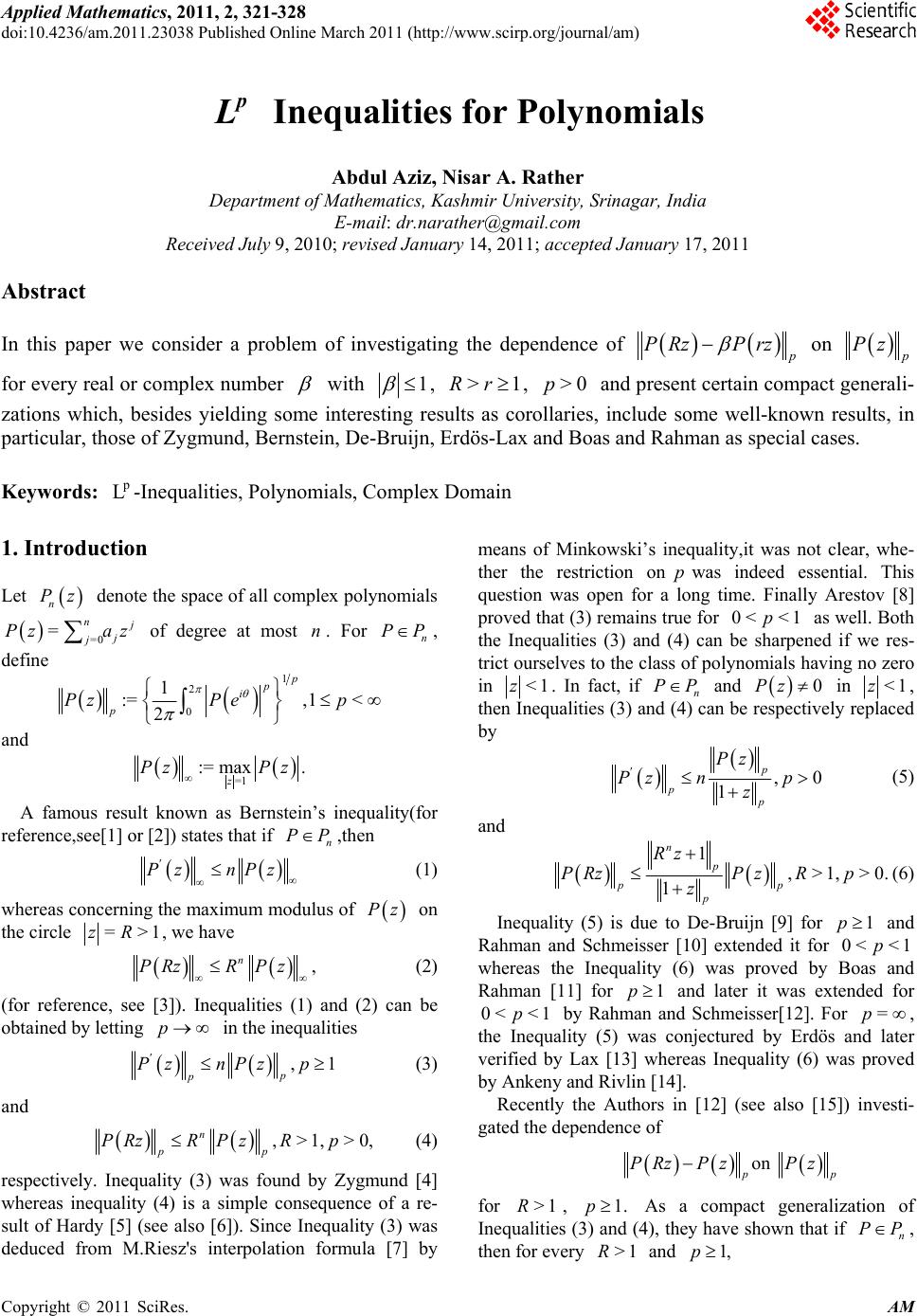 Applied Mathematics, 2011, 2, 321-328 doi:10.4236/am.2011.23038 Published Online March 2011 (http://www.scirp.org/journal/am) Copyright © 2011 SciRes. AM p L Inequalities for Polynomials Abdul Aziz, Nisar A. Rather Department of Mathematics, Kashmir University, Srinagar, India E-mail: dr.narather@gmail.com Received July 9, 2010; revised January 14, 2011; accepted January 17, 2011 Abstract In this paper we consider a problem of investigating the dependence of p PRz Prz on p Pz for every real or complex number with 1 , >1 R r, >0p and present certain compact generali- zations which, besides yielding some interesting results as corollaries, include some well-known results, in particular, those of Zygmund, Bernstein, De-Bruijn, Erdös-Lax and Boas and Rahman as special cases. Keywords: p L-Inequalities, Polynomials, Complex Domain 1. Introduction Let n Pz denote the space of all complex polynomials =0 =n j j j Pz az of degree at most n. For n PP , define 1 2 0 1 :=,1 < 2 p p i p PzPep and =1 := max. z Pz Pz A famous result known as Bernstein’s inequality(for reference,see[1] or [2]) states that if n PP,then ' Pz nPz (1) whereas concerning the maximum modulus of Pz on the circle =>1zR , we have , n PRzR Pz (2) (for reference, see [3]). Inequalities (1) and (2) can be obtained by letting p in the inequalities ,1 ' p p PznPz p (3) and ,>1,>0, n pp PRzRPzRp (4) respectively. Inequality (3) was found by Zygmund [4] whereas inequality (4) is a simple consequence of a re- sult of Hardy [5] (see also [6]). Since Inequality (3) was deduced from M.Riesz's interpolation formula [7] by means of Minkowski’s inequality,it was not clear, whe- ther the restriction onpwas indeed essential. This question was open for a long time. Finally Arestov [8] proved that (3) remains true for 0< <1p as well. Both the Inequalities (3) and (4) can be sharpened if we res- trict ourselves to the class of polynomials having no zero in <1z. In fact, if n PP and 0Pz in <1z, then Inequalities (3) and (4) can be respectively replaced by ,0 1 p ' pp Pz Pz np z (5) and 1,>1,>0. 1 n p pp p Rz PRzPz Rp z (6) Inequality (5) is due to De-Bruijn [9] for 1p and Rahman and Schmeisser [10] extended it for 0< <1p whereas the Inequality (6) was proved by Boas and Rahman [11] for 1p and later it was extended for 0< <1p by Rahman and Schmeisser[12]. For =p , the Inequality (5) was conjectured by Erdös and later verified by Lax [13] whereas Inequality (6) was proved by Ankeny and Rivlin [14]. Recently the Authors in [12] (see also [15]) investi- gated the dep endence o f on p p PRz PzPz for >1R, 1.p As a compact generalization of Inequalities (3) and (4), they have shown that if n PP , then for every >1R and 1,p  A. AZIZ ET AL. Copyright © 2011 SciRes. AM 322 1. n p p PRz PzRPz (7) It is natural to seek the corresponding an alog of (7) for polynomials n PP having no zero in <1z and which is a compact generalization of Inequalities (5) and (6). In the present paper we consider a more general pro- blem of investigating the dependence of on p p PRz PrzPz for every real or complex number with 1 , >1Rr, >0p and develop a unified method for arri- ving at these results. We first present the following inter- esting result and a compact generalization of Inequalities (3) and (4), which also extends Inequality (7) for 0< <1p as well. Theorem 1. If n PP, then for every real or complex number with 1 , >1Rr and >0p, . nn p p PRzPrzRr Pz (8) The result is best possible and equality in (8) holds for =,0. n Pzaz a Remark 1. For =0 , Theorem 1 reduces to Inequality (4) and for =1 , =1r, it validates Inequality (7) for each >0p. If we set =1 in Inequality (8), we immediately get the following generalization of Inequality (7). Corollary 1. If n PP, then for >1Rr and >0p . nn p p PRz PrzR r Pz (9) The result is best possible and equality in (9) holds for =,0. n Pzaz a If we divide the two sides of Inequality (9) by Rr and let Rr, we get: Corollary 2. If n PP, then for 1r and >0p, 1. 'n p p PrznrPz (10) Remark 2. For =1r, Corollary 2 reduces to Zygmund’s Inequality (3) for each >0p. The following result which is a compact generalization of Inequalities of (1) and (2) follows from Theorem 1 by letting p in Inequality (8). Corollary 3. If n PP, then for every real or complex number with 1 and >1Rr, =1 maxfor=1. nn z PRzPrz RrPzz (11) The result is best possible and equality in (11) ho lds for =,0. n Pzaz a Remark 3. For =0 , Corollary 3 reduces to Inequality (2) and for =1 , if we divide the two sides of (11) by Rr and let Rr, it follows that if n PP , then for 1r, 1 =1 maxfor =1. 'n z Prz nrPzz (12) Inequality (12) reduces to Bernstein’s Inequality (1) for =1r. For polynomials n PP having no zero in <1z, we next prove the following interesting improvement of (8) which among other things include De-Bruijn’s theo- rem (Inequality (5)) and a result of Boas and Rahman (Inequality (6)) as special cases. Theorem 2. If n PP and Pz does not va nish in <1z, then for every real or complex number with 1 , >1Rr and >0p 1. 1 nn p p p p Rrz PRz PrzPz z (13) The result is best possible and equality in (13) ho lds for =,==1. n Pzaz bab For =0 , Theorem 2 reduces to Inequality (6). A variety of interesting results can be easily deduced from Theorem 2. Here we mention a few of these. The following corollary immediately follows from Theorem 2 by taking =1 . Corollary 4. If n PP and Pz does not vanish in <1z, then for >1Rr and >0p, . 1 nn p p p Rr PRz PrzPz z (14) The result is sharp and equality in (14) holds for ()=, ==1. n Pzaz bab Remark 4. For =1r, if we divide the two sides of (14) by 1R and let 1R,we immediately get De-Bruijn’s theorem (Inequality (5)) for each >0p. Next we mention the following compact generaliza- tion of a theorem of Erdös and Lax (Inequality (5) for p ) and a result of Ankeny and Rivlin (Inequality (5) for p ) which immediately follows from Theorem 2 by letting p in (13). Corollary 5. If n PP and Pz does not vanish in <1z, then for every real or complex number with 1 and >1Rr, =1 1max 2 for=1. nn z Rr PRz PrzPz z (15) The result is best possible and equality in (15) ho lds for =,==1. n Pzaz ba b 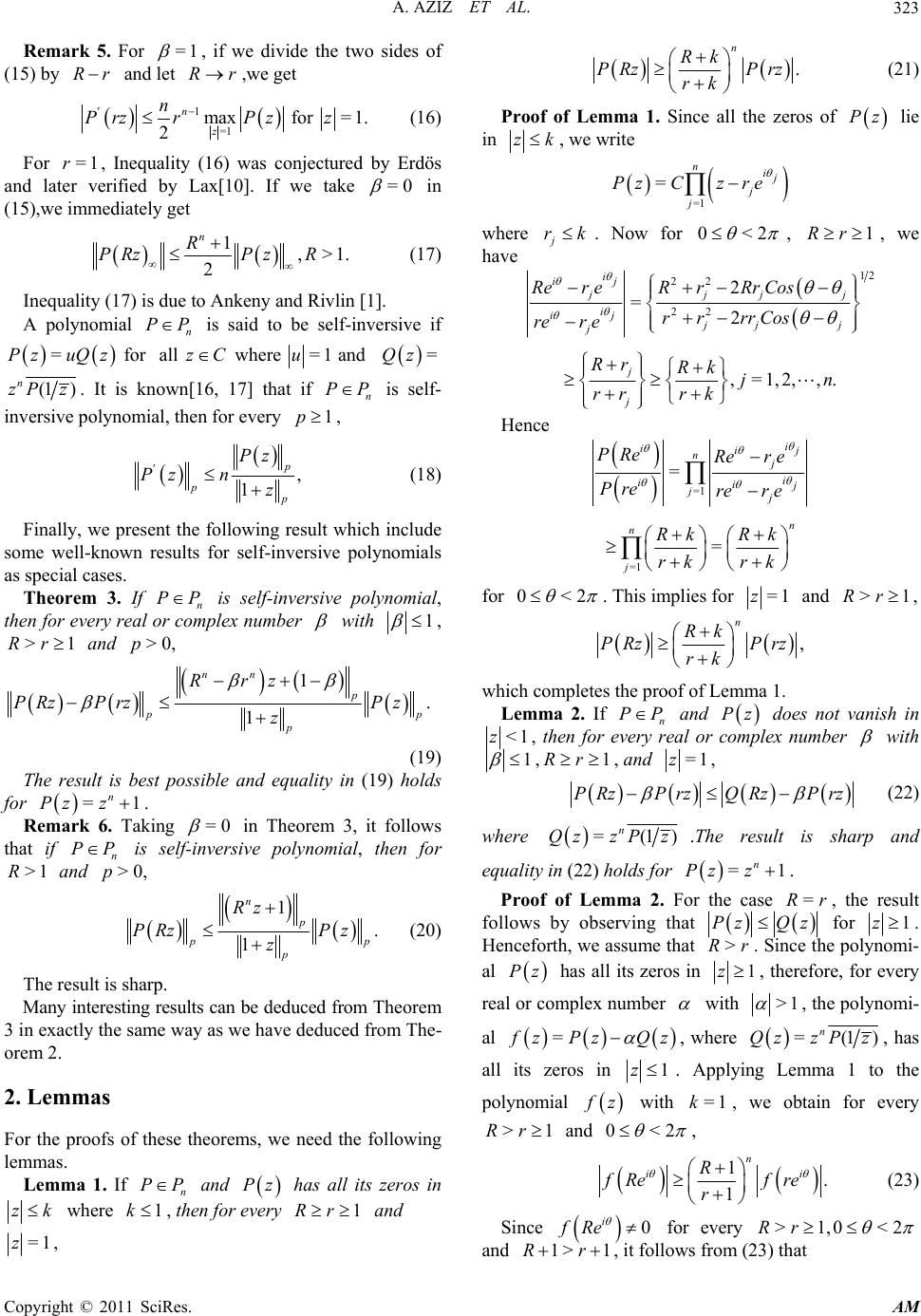 A. AZIZ ET AL. Copyright © 2011 SciRes. AM 323 Remark 5. For =1 , if we divide the two sides of (15) by Rr and let Rr,we get 1 =1 maxfor=1. 2 'n z n Prz rPzz (16) For =1r, Inequality (16) was conjectured by Erdös and later verified by Lax[10]. If we take =0 in (15),we immediately get 1,>1. 2 n R PRzPz R (17) Inequality (17) is due to Ankeny and Rivlin [1]. A polynomial n PP is said to be self-inversive if =PzuQz for allzCwhere =1uand =Qz (1 ) n zP z. It is known[16, 17] that if n PP is self- inversive polynomial, then for every 1p, , 1 p ' pp Pz Pzn z (18) Finally, we present the following result which include some well-known results for self-inversive polynomials as special cases. Theorem 3. If n PP is self-inversive polynomial, then for every real or complex number with 1 , >1Rr and >0,p 1. 1 nn p p p p Rrz PRz PrzPz z (19) The result is best possible and equality in (19) ho lds for =1 n Pz z. Remark 6. Taking =0 in Theorem 3, it follows that if n PP is self-inversive polynomial, then for >1R and >0,p 1. 1 n p p p p Rz PRz Pz z (20) The result is sharp. Many interesting results can be deduced from Th eor em 3 in exactly the same way as we have deduced from The- orem 2. 2. Lemmas For the proofs of these theorems, we need the following lemmas. Lemma 1. If n PP and Pz has all its zeros in zk where 1k, then for every 1Rr and =1z, . n Rk PRz Prz rk (21) Proof of Lemma 1. Since all the zeros of Pz lie in zk , we write =1 =ni j j j PzCz re where j rk . Now for 0<2 , 1Rr , we have 12 22 22 2 =2 i ij jjjj i ijjj j j RereRrRr Cos rr rrCos rer e ,=1,2,, . j j Rr Rk jn rr rk Hence =1 = i ii j nj i ii j jj PRe Rer e Pre rer e =1 = n n j Rk Rk rk rk for 0<2 . This implies for =1z and >1Rr, , n Rk P RzP rz rk which completes the proof of Lemma 1. Lemma 2. If n PP and Pz does not vanish in <1z, then for every real or complex number with 1 ,1Rr, and =1z, P Rz PrzQRz Prz (22) where =(1) n QzzP z .The result is sharp and equality in (22) holds for =1 n Pz z. Proof of Lemma 2. For the case =Rr, the result follows by observing that Pz Qz for 1z. Henceforth, we assume that >Rr. Since the polynomi- al Pz has all its zeros in 1z, therefore, for every real or complex number with >1 , the polynomi- al = f zPz Qz , where =(1) n QzzP z, has all its zeros in 1z . Applying Lemma 1 to the polynomial f z with =1k, we obtain for every >1Rr and 0<2 , 1. 1 n ii R fRe fre r (23) Since 0 i fRe for every >1,0 <2Rr and 1> 1Rr , it follows from (23) that  A. AZIZ ET AL. Copyright © 2011 SciRes. AM 324 1 >1 n iii r f Ref Refre R for every >1Rr and 0<2 . This gives < f rzfRz , for 1z and >1Rr. Using Rouche’s theorem and noting that all the zeros of f Rz lie in 1<1, zR we conclude that the polynomial = = Tz fRzfrz PRzPrzQ RzQ rz (24) has all its zeros in <1z for every real or complex number , with 1, >1 and >1Rr. This implies P RzPrzQ RzQ rz (25) for 1z and >1Rr. If Inequality (25) is not true, then exist a point = z w with 1w such that >.PRwP rwQ RwQ rw But all the zeros of Qz lie in 1z, therefore, it follows (as in case of f z) that all the zeros of QRz Qrz lie in <1z. Hence 0QRw Qrw with 1w. We take =, PRw Prw QRwQrw then is a well defined real or complex number with >1 and with this choice of , from (24) we obtain =0Tw where 1w. This contradicts the fact that all the zeros of ()Tz lie in <1z. Thus P RzPrzQ RzQ rz for 1z and >1Rr. This proves Lemma 2. Next we describe a result of Arestov. For 01 =,,, n and =0 =nj j n j Pzaz P , we define =0 =. n j jj j Pz az The operator is said to be admissible if it pre- serves one of the following properties: 1) Pz has all its zeros in :1,zCz 2) Pz has all its zeros in :1,zCz The result of Arestov may now be stated as follows. Lemma 3. [8] Let = x logx where is a convex nondecreasing function on .R Then for all n PP and each admissible operator , 22 00 , ii Pe dCnPe d where 0 ,=ax, . n Cn In particular, Lemma 3 applies with :p x x for every 0,p . Therefore, we have 11 22 00 ,. p p pp ii PedCnPed (26) We use (26) to prove the following interesting result. Lemma 4. If n PP and Pz does not vanish in <1z, then for every real or complex number with 1, >1Rr , >0p and real, 2 0 2 0 1. ii p inini pp nnii PRe Pre eRPeRrPe rd Rre Ped (27) Proof of Lemma 4. Let =1 n QzzPz . Since Pz does no t vanish in <1z, by Lemma 2, for every real or complex number with 1,>1Rr and =1z,we have =nn PRz Prz QRzQrz RPzRrPzr Now(as in the proof of Lemma 2) , the polynomial ==11 nn nn HzQRzQrzRzPRzrzP rz has all its zeros in <1z for every real or complex number with 1 and >Rr, it follows that the polynomi al 1= nn n zH zRPzRrPzr has all its zeros in >1z. Hence the function =nn PRz Prz fz RPzR rPzr is analytic in 1z and 1fz for =1z. Since f z is not a constant, it follows by the Maximum Modulus Principle that <1 for <1,fzz or equivalently, < for <1. nn PRzPrz RPzRrPzrz (28) A direct application of Rouche’s theorem shows that 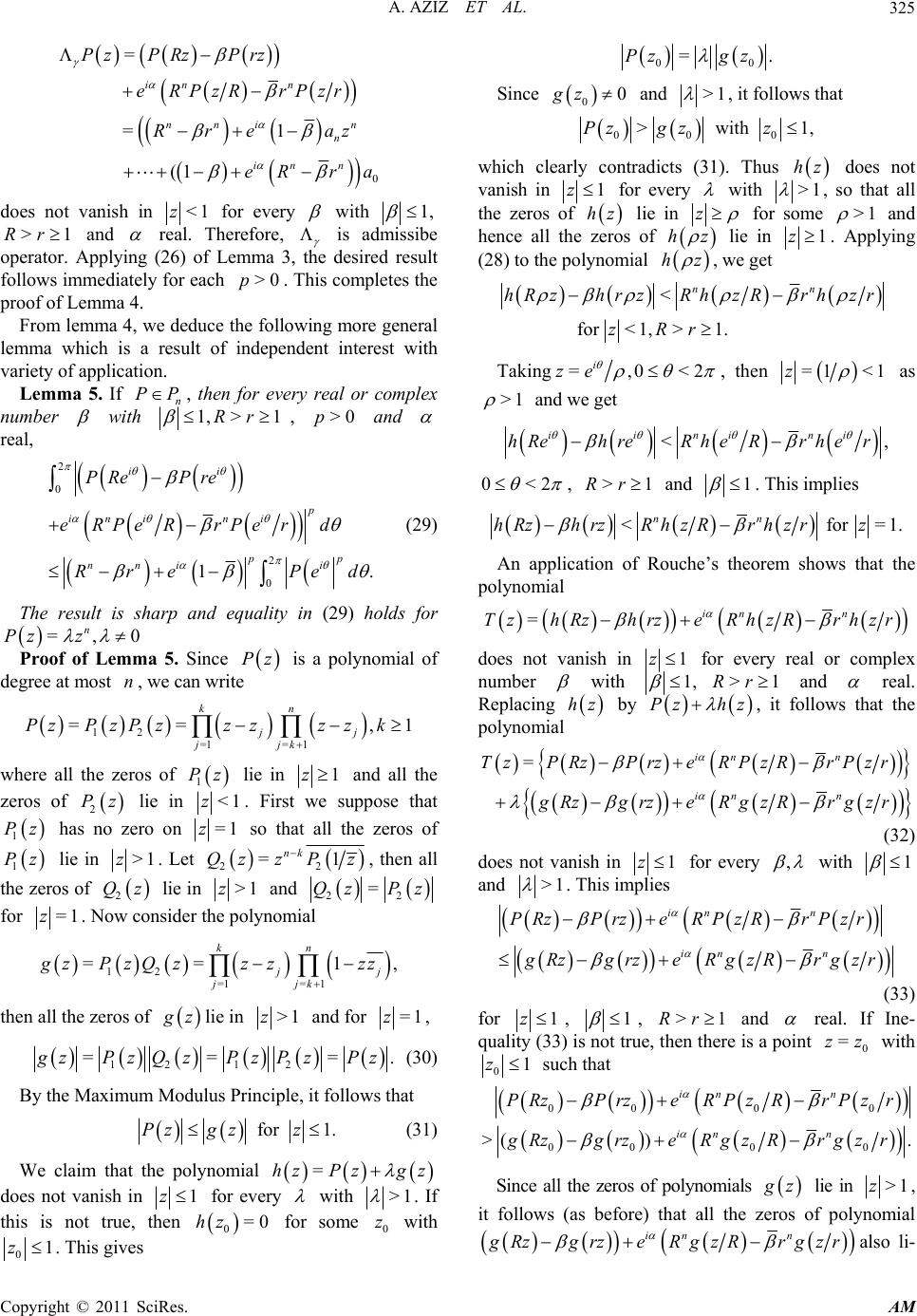 A. AZIZ ET AL. Copyright © 2011 SciRes. AM 325 0 = =1 (1 in n nnin n in n Pz PRzPrz e RPzRrPzr Rre az eR ra does not vanish in <1z for every with 1, >1Rr and real. Therefore, is admissibe operator. Applying (26) of Lemma 3, the desired result follows immediately for each >0p. This completes the proof of Lemma 4. From lemma 4, we deduce the following more general lemma which is a result of independent interest with variety of application. Lemma 5. If n PP, then for every real or complex number with 1, >1Rr , >0p and real, 2 0 2 0 1. ii p inini pp nnii PRe Pre eRPeRrPer d Rre Ped (29) The result is sharp and equality in (29) holds for =,0 n Pz z Proof of Lemma 5. Since Pz is a polynomial of degree at most n, we can write 12 =1= 1 == ,1 kn jj jjk PzPzPzzzzz k where all the zeros of 1 Pz lie in 1z and all the zeros of 2 Pz lie in <1z. First we suppose that 1 Pz has no zero on =1z so that all the zeros of 1 Pz lie in >1z. Let 22 =1 nk Qzz Pz , then all the zeros of 2 Qz lie in >1z and 22 =Qz Pz for =1z. Now consider the polynomial 12 =1= 1 == 1, kn jj jjk g zPzQz zzzz then all the zeros of g zlie in >1z and for =1z, 12 12 ===. g zPzQzPzPzPz (30) By the Maximum Modulus Principle, it follows that for 1.Pz gzz (31) We claim that the polynomial =hzPzgz does not vanish in 1z for every with >1 . If this is not true, then 0=0hz for some 0 z with 01z. This gives 00 =.Pz gz Since 00gz and >1 , it follows that 00 0 >with 1,Pzgzz which clearly contradicts (31). Thus hz does not vanish in 1z for every with >1 , so that all the zeros of hz lie in z for some >1 and hence all the zeros of hz lie in 1z. Applying (28) to the polynomial hz , we get < for<1,>1. nn hRzhrzRhzRrhzr zRr Taking =,0<2 i ze , then =1 <1z as >1 and we get <, iinini hRehreRheRrher 0<2 , >1Rr and 1 . This implies < for =1. nn hRzhrz RhzRrhzrz An application of Rouche’s theorem shows that the polynomi al =in n TzhRzhrzeRhzRrhzr does not vanish in 1z for every real or complex number with 1, >1Rr and real. Replacing hz by Pz hz , it follows that the polynomi al =in n TzPRzPrz e RPzRrPzr inn g RzgrzeRgz Rrgz r (32) does not vanish in 1z for every , with 1 and >1 . This implies in n inn PRzPrze RPzRrPzr g RzgrzeRgz Rrgz r (33) for 1z , 1 , >1Rr and real. If Ine- quality (33) is not true, then there is a point 0 =zz with 01z such that 000 0 in n PRzPrzeRPz RrPzr 000 0 >( ). in n g RzgrzeRg zRrg zr Since all the zeros of polynomials g z lie in >1z, it follows (as before) that all the zeros of polynomial inn g RzgrzeRg zRrgzr also li- 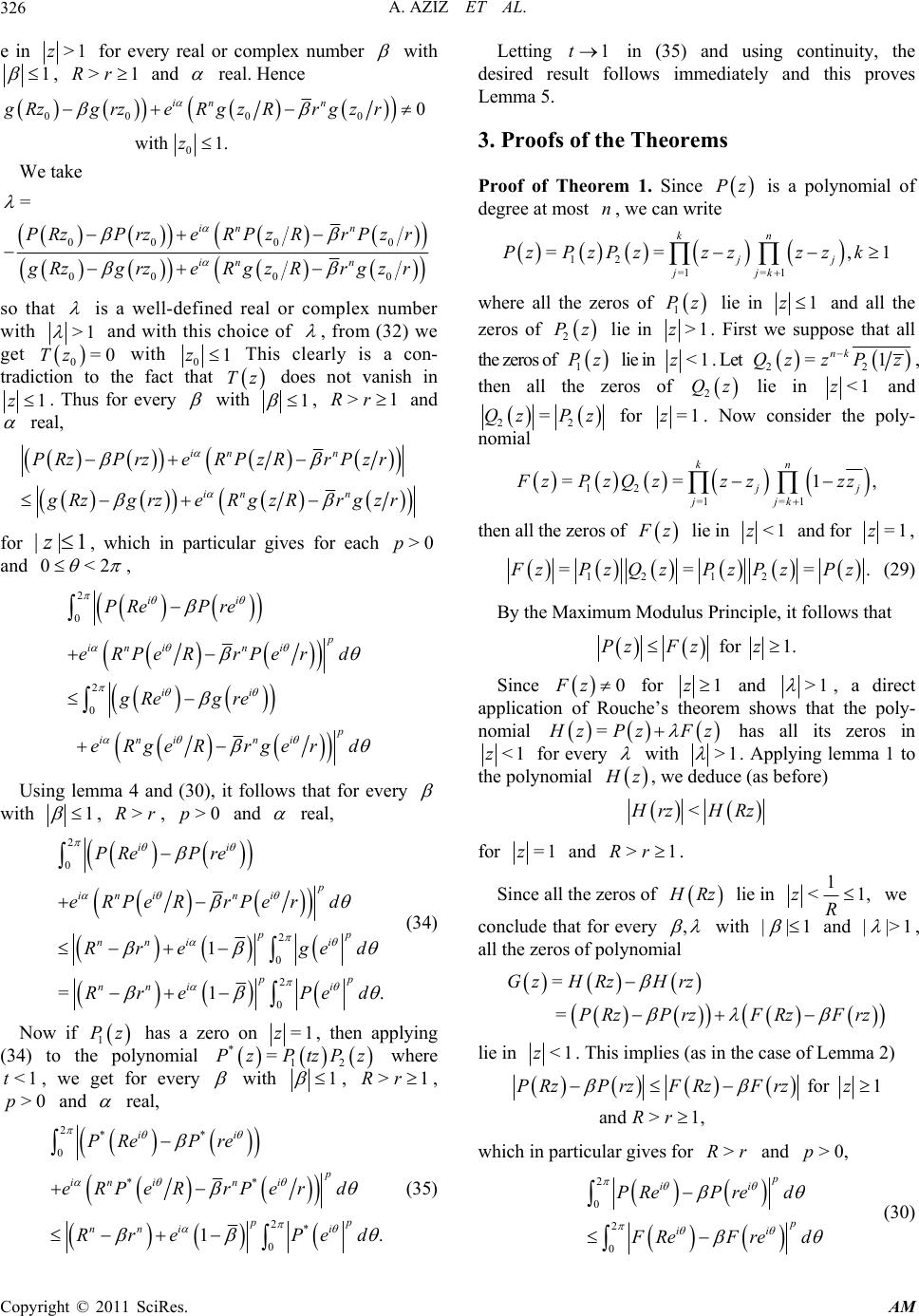 A. AZIZ ET AL. Copyright © 2011 SciRes. AM 326 e in >1z for every real or complex number with 1 , >1Rr and real. Hence 000 0 0 0 with 1. in n gRzgrzeRgzRrgz r z We take 0000 000 0 = in n in n PRzPrzeRPz RrPzr g RzgrzeRg zRrg zr so that is a well-defined real or complex number with >1 and with this choice of , from (32) we get 0=0Tz with 01z This clearly is a con- tradiction to the fact that Tz does not vanish in 1z. Thus for every with 1 , >1Rr and real, in n inn PRzPrzeRPzRrPzr g Rzg rzeRg zRrg zr for ||1z, which in particular gives for each >0p and 0<2 , 2 0 2 0 ii p inini ii p ini ni PRe Pre eRPeRrPer d gRegre eRgeRrge rd Using lemma 4 and (30), it follows that for every with 1 , >Rr, >0p and real, 2 0 2 0 2 0 1 =1 . ii p inini pp nnii pp nnii PRe Pre eRPeRrPer d Rre ged Rre Ped (34) Now if 1 Pz has a zero on =1z, then applying (34) to the polynomial *12 =Pz PtzPz where <1t, we get for every with 1 , >1Rr, >0p and real, 2** 0 ** 2* 0 1. ii p in in i pp nnii PRe Pre eRPeRrPer d Rre Ped (35) Letting 1t in (35) and using continuity, the desired result follows immediately and this proves Lemma 5. 3. Proofs of the Theor ems Proof of Theorem 1. Since Pz is a polynomial of degree at most n, we can write 12 =1= 1 == ,1 kn jj jjk PzPzP zzzzzk where all the zeros of 1 Pz lie in 1z and all the zeros of 2 Pz lie in >1z. First we suppose that all the zeros of 1 Pz lie in <1z. Let 22 =1 nk Qzz Pz , then all the zeros of 2 Qz lie in <1z and 22 =Qz Pz for =1z. Now consider the poly- nomial 12 =1= 1 == 1, kn jj jjk F zPzQz zzzz then all the zeros of F z lie in <1z and for =1z, 12 12 ===. F zPzQzPzPzPz (29) By the Maximum Modulus Principle, it follows that for 1.PzFzz Since 0Fz for 1z and >1 , a direct application of Rouche’s theorem shows that the poly- nomial = H zPz Fz has all its zeros in <1z for every with >1 . Applying lemma 1 to the polynomial H z, we deduce (as before) < H rzH Rz for =1z and >1Rr. Since all the zeros of H Rz lie in 1 <1,zR we conclude that for every , with ||1 and ||>1 , all the zeros of polynomial = = Gz HRzHrz P RzP rzFRzFrz lie in <1z. This implies (as in the case of Lemma 2) for 1 and>1, PRzPrzFRzFrzz Rr which in particular gives for >Rr and >0,p 2 0 2 0 p ii p ii PRePre d F ReFred (30)  A. AZIZ ET AL. Copyright © 2011 SciRes. AM 327 Again, since all the zeros of F z lie in 1z , as before, F RzF rz has all its zeros in 1z for every real or complex number with 1 . There- fore, the operator defined by 0 = =1 nnn n Fz FRzFrz Rrbz b is admissible. Hence by (26) of Lemma (3), for each >0p, we have 2 0 2 0. p ii p p nn i F ReF red Rr Fed (31) Combining Inequalities (37) and (38) and noting that = ii F ePe , we obtain for >1Rr and >0p 1 2 0 1 2 0. p p ii p p nn i PRePre d Rr Ped (32) In case 1 Pz has a zero on =1z, the Inequality (39) follows by using similar argument as in the case of Lemma 5. This completes the proof of Theorem 1. Proof of Theorem 2. By hypothesis n PP and Pz does not vanish in 1z , therefore, b y Lemma 2 for every real or complex number with 1 , 0<2 and >1Rr, ii ni ni PRe Pre RPe RrPe r (33) Also, by Lemma 5, 2 0 2 0 1 p i pp nnii FeGd Rre Ped (34) where =ii F PRe Pre and =. ni ni GRPeRrPer Integrating both sides of (41) with respect to from 0 to 2 , we get for each >0p, >1Rr and real, 22 00 p i F eG dd 22 00 1pp nnii RredPed (35) Now for every real , 1t and >0p, we have 22 00 1. pp ii te de d If 0F , we take =tG F , then by (40) 1t and we get 2 0 2 0 2 0 2 0 2 0 =1 = = 1. p i p pi p pi p pi p pi FeGd G F ed F G F ed F G F ed F Fed For =0F , this inequality is trivially true. Using this in(42), we conclude that for every real or complex number with 1 , >1Rr and real, 22 00 22 00 1 1. p p iii pp nnii edPRePred RredPed (43) Since 2 0 2 0 2 0 2 0 2 0 1 =1 =1 =1 =1, p nni p nni p nni p nni p nni Rre d Rre d Rre d Rre d Rre d (44) the desired result follows immediately by combining (43) and (44). This completes the proof of Theorem 2. Proof of Theorem 3. Since Pz is a self-inversive polynomial, we have =PzuQz for all zC where =1u and =1 n QzzPz . Therefore, for every real or complex number and >1Rr, = for all PRzPrzQ RzQ rzzC so that ==1. ii ni ni PRe Pre GF RPeRrPer 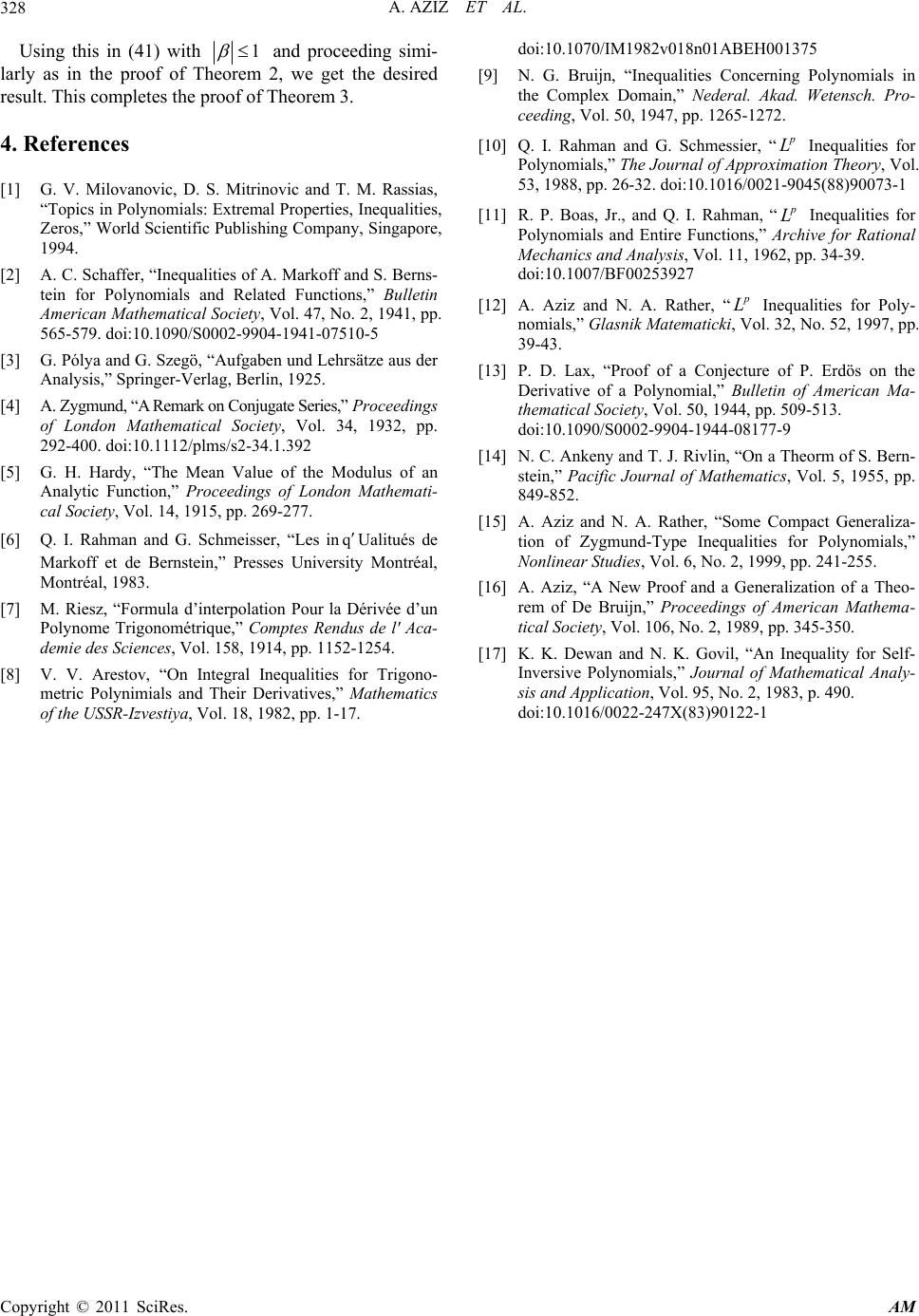 A. AZIZ ET AL. Copyright © 2011 SciRes. AM 328 Using this in (41) with 1 and proceeding simi- larly as in the proof of Theorem 2, we get the desired result. This completes the proof of Theorem 3. 4. References [1] G. V. Milovanovic, D. S. Mitrinovic and T. M. Rassias, “Topics in Polynomials: Extremal Properties, Inequalities, Zeros,” World Scientific Publishing Company, Singapore, 1994. [2] A. C. Schaffer, “Inequalities of A. Markoff and S. Berns- tein for Polynomials and Related Functions,” Bulletin American Mathematical Society, Vol. 47, No. 2, 1941, pp. 565-579. doi:10.1090/S0002-9904-1941-07510-5 [3] G. Pólya and G. Szegö, “Aufgaben und Lehrsätze aus der Analysis,” Springer-Verlag, Berlin, 1925. [4] A. Zygmund, “A Remark on Conjugate Series,” Proceedings of London Mathematical Society, Vol. 34, 1932, pp. 292-400. doi:10.1112/plms/s2-34.1.392 [5] G. H. Hardy, “The Mean Value of the Modulus of an Analytic Function,” Proceedings of London Mathemati- cal Society, Vol. 14, 1915, pp. 269-277. [6] Q. I. Rahman and G. Schmeisser, “Les inqUalitués de Markoff et de Bernstein,” Presses University Montréal, Montréal, 1983. [7] M. Riesz, “Formula d’interpolation Pour la Dérivée d’un Polynome Trigonométrique,” Comptes Rendus de l' Aca- demie des Sciences, Vol. 158, 1914, pp. 1152-1254. [8] V. V. Arestov, “On Integral Inequalities for Trigono- metric Polynimials and Their Derivatives,” Mathematics of the USSR-Izvestiya, Vol. 18, 1982, pp. 1-17. doi:10.1070/IM1982v018n01ABEH001375 [9] N. G. Bruijn, “Inequalities Concerning Polynomials in the Complex Domain,” Nederal. Akad. Wetensch. Pro- ceeding, Vol. 50, 1947, pp. 1265-1272. [10] Q. I. Rahman and G. Schmessier, “ p L Inequalities for Polynomials,” The Journal of Approximation Theory, Vol. 53, 1988, pp. 26-32. doi:10.1016/0021-9045(88)90073-1 [11] R. P. Boas, Jr., and Q. I. Rahman, “ p L Inequalities for Polynomials and Entire Functions,” Archive for Rational Mechanics and Analysis, Vol. 11, 1962, pp. 34-39. doi:10.1007/BF00253927 [12] A. Aziz and N. A. Rather, “ p L Inequalities for Poly- nomials,” Glasnik Matematicki, Vol. 32, No. 52, 1997, pp. 39-43. [13] P. D. Lax, “Proof of a Conjecture of P. Erdös on the Derivative of a Polynomial,” Bulletin of American Ma- thematical Society, Vol. 50, 1944, pp. 509-513. doi:10.1090/S0002-9904-1944-08177-9 [14] N. C. Ankeny and T. J. Rivlin, “On a Theorm of S. Bern- stein,” Pacific Journal of Mathematics, Vol. 5, 1955, pp. 849-852. [15] A. Aziz and N. A. Rather, “Some Compact Generaliza- tion of Zygmund-Type Inequalities for Polynomials,” Nonlinear Studies, Vol. 6, No. 2, 1999, pp. 241-255. [16] A. Aziz, “A New Proof and a Generalization of a Theo- rem of De Bruijn,” Proceedings of American Mathema- tical Society, Vol. 106, No. 2, 1989, pp. 345-350. [17] K. K. Dewan and N. K. Govil, “An Inequality for Self- Inversive Polynomials,” Journal of Mathematical Analy- sis and Application, Vol. 95, No. 2, 1983, p. 490. doi:10.1016/0022-247X(83)90122-1 |

